Introduction
We completed our ecobottles so we could find out what the keys to an ecosystem chain are, and so that we could see what things are needed in this chain. For instance, in order to keep clean water, we had to put in a coffee filter with sand to filter. In the terrestrial chamber, we had to put dirt and sand for the worms and crickets.
Procedure
We built our Ecobottle according to the worksheet of instructions that we had.

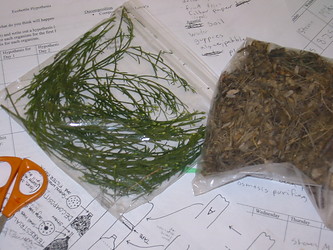
Materials and Plans© 2005
The first thing we built was the Aquatic section.
- In this section we put sand on the bottom.
- On top of it we put five to six smallish stones.
- We were going to put a beta fish in but I decided against it.
- Before we filled the aquatic section with water, we put in the plants.
The second section we built was the Decomposition chamber.
- In this section we put 5 coffee filters to filter the water.
- In order to filter the water better, we put in sand and 5 more coffee filters.
- Above these filters, we put compost, twigs, leaves, dirt, and orange peels.
- We hope in the future we will also put fruit flies.
The final chamber we built was the Terrestrial section.
- In this we put dirt, sand, and compost.
- For growth, we planted basil seeds.
- To have creatures we put meal worms and crickets.

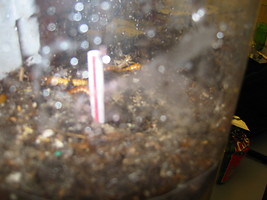
The terrestrial section with worms and crickets © 2005
The last thing we did to the ecobottle after we sealed it up was put a hole in the side of the aquatic section to take water samples. We put tape over this hole and only opened it when taking out water.
Hypotheses
Environment: Aquatic
Organism : Aquarium plant
- Hypothesis for day 1-5: It will live.
Environment: Decomposition
Organism: Fungus
- Hypothesis for day 1: It will not be there.
- Hypothesis for day 2: It will not be there.
- Hypothesis for day 3: It will sort of be there.
- Hypothesis for day 4: It will sort of be there.
- Hypothesis for day 5: It will be there.
Each day we will test this hypothesis by: Look for a low-to-the-orange fuzz.
Environment: Terrestrial
Organism: Worms, Crickets
- Hypothesis for day 1-5: They will live.
We will test this hypothesis by: See if they move.
Organism: Basil
- Hypothesis for day 1: It will be underground.
We will test this hypothesis by: Look for a green plant.
Observations:
Scientific Observation Procedures:
- In order to measure water temperature, we took a pipette and took out a small sample of water. We then put that sample and placed it in a beaker with a thermometer. We waited about 2 min., in case of change, and looked at the thermometer.
Specific Observations:
9/30/05
The water is clean enough to see. The plants in the water are alive and well. Today we put orange peels in the decomposition chamber. Both the worms and the crickets seem to be doing well. We put grass seeds in to feed them.
10/03/05 - From what I have seen, most of the worms have died. Some are still squirming around. Both of the crickets are alive. And the water is dirty enough to kill a fish.
10/04/05 - Our worms and crickets are still alive. We have discovered three spots of green where grass is trying to grow. Besides that, everything is the same.
10/6/05 - The worms are still alive as are the crickets. We have some grass growing in the decomposition. The aquatic is dirty, but it hasn't gotten any worse. It smells bad.
10/7/05 - The water is REALLY dirty. The worms are mostly dead. The crickets are staying alive. Decomposition hasn't changed. We've got a lot of white dots in the terrestrial chamber.
10/11/05 - The water is looking more and more like Rootbeer. Our Ecobottle is leaking. All of our worms have died. One cricket is left.
10/14/05: Group Observation:
- Terrestrial Chamber: The cricket is getting bigger. Despite the fact that we put in seeds, there are no plants growing. Either the worms are dead, or they got smart and went underground.
- Decomposition Chamber: The orange peel is growing fungus. Everything is moist.
- Aquatic Chamber: The plants are still growing pretty well, surprisingly. The water is really dark. It is also over the level that my partner and I agreed on.
Observation of a specific organism
The organism that I chose to observe was the big cricket that survived a while after the others died. This cricket managed to stay alive through everything. I think that there might have been some grass seeds growing and he ate them before they could get bigger. Not only did it surprise me to see the cricket living when the other animals had died, but it shocked me to see him getting bigger. Another way it could've grown was eating the dead worms. This is what Darwin called evolution. The cricket survived the floods we put upon him for the plants two chambers below.
Analysis:
R.I.P. Timeline
- 10/3/05 - Some of the worms have died.
- 10/11/05 - All of the worms have died.
- 10/18/05 - One cricket has died.
- 11/4/05 - The big cricket has died.
Graphs


This is a Venn diagram that one of us did to compare our ecobottle to the ecobottle of another group, the Generics © 2005 Rollingthunder3Rollingthunder3
Conclusion:
From this ecobottle we learned in what order certain objects should be put into the bottle. We also learned how much time everything takes to grow. Before you start your ecobottle, you have to know about the tree of life and what everything needs to survive, and include that "everything" in your ecobottle. Many things will die, but that's how it works. Do research on what plants to get and make a full habitat for that organism. For our next project we will make sure the water is cleaner so we can study fish and other aquatic creatures. We need to know how many layers of filter paper we need to put in to make sure to water is clear. Next time we do this project, we will research what types of worms work best in the soil, and make sure everything connects.
Information on the Internet
- Annenberg Media: Bottle Biology The Bottle Biology site is a great place to learn about how to make ecocolumns.
- Wisconsin Fast Plants The Fast Plants site provides a wealth of information on how to use special types of plants for ecobottle investigations.

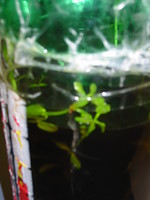
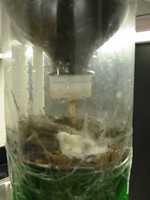
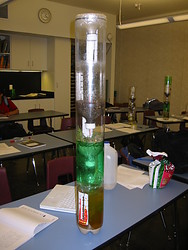
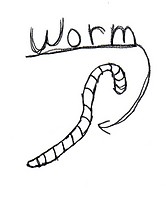
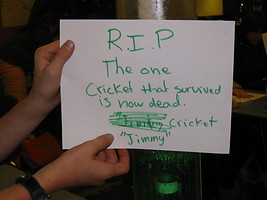
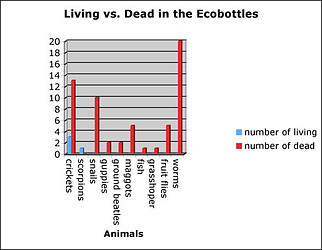


 Go to quick links
Go to quick search
Go to navigation for this section of the ToL site
Go to detailed links for the ToL site
Go to quick links
Go to quick search
Go to navigation for this section of the ToL site
Go to detailed links for the ToL site